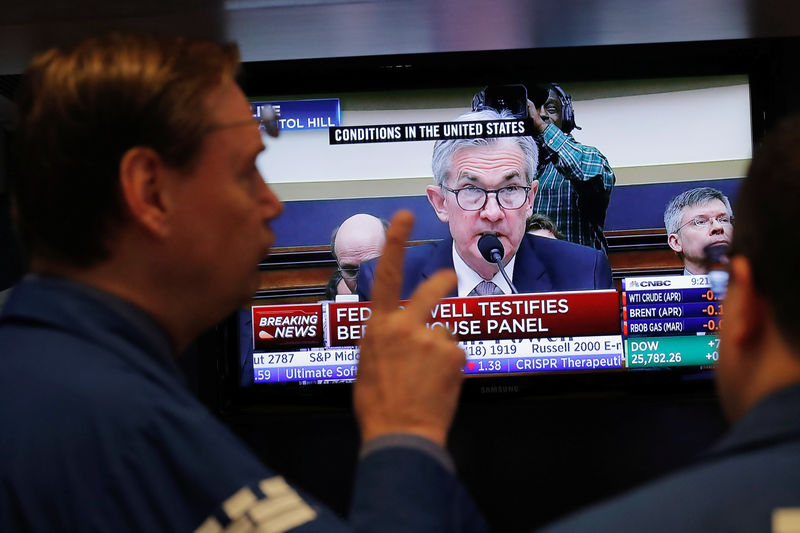By Geoffrey Smith
Investing.com -- The Federal Reserve is set to raise interest rates for the first time in over three years - but how many more hikes will the central bank guide for this year? Retail sales data for February are due. China's government and central bank promise support to the economy and to financial markets, triggering the biggest one-day rally in Chinese stocks in years. U.S. stocks are set to build on Tuesday's gains as oil remains under pressure, relieving some of the fears about stagflation. And the Russian Federation is expected to miss payments on its international debt for the first time. Here's what you need to know in financial markets on Wednesday, 16th March.
1. Fed set to start rate hike cycle; February retail sales due
The Federal Reserve is set to raise interest rates for the first time since 2018 when it winds up its regular policy meeting at 2 PM ET (1800 GMT).
Consensus expectations are for a 25 basis point increase in the fed funds target range, taking it to 0.25%-0.5%. A bigger hike of a 50 basis points hasn’t been entirely ruled out but would go against the guidance given by Chairman Jerome Powell at his recent Congressional testimony. Wall Street analysts suggest the Fed will raise rates by some 150-175 basis points in all this year, as well as starting the run-off of the massive bond portfolio it has accumulated over the last two years.
A minority argues that such dramatic tightening won’t be necessary, due to the economic slowdown to be expected from the impact of war in Ukraine and higher energy prices. February’s retail sales data, due at 8:30 AM ET, may throw some light on how much the U.S. consumer has been affected so far by such factors.
2. Team China charges to the rescue
China’s stock markets roared to their biggest one-day gain in years after coordinated statements from the central bank and the government promising support both to the economy in general and – in a rare move – to financial markets in particular.
Chinese stocks had slumped in recent days on a combination of fears over Covid-related lockdowns, regulatory campaigns against tech companies, and the threat of delisting from U.S. exchanges. The property sector continues to suffer from a much-needed deleveraging process, meanwhile.
The statements from the government promised a measured approach to domestic regulation and said progress was being made in talks with the U.S.
3. Stocks set to open higher as oil slides again
U.S. stock markets are set to open higher later, with early trading set to be dominated by the retail sales numbers and later developments completely dependent on the Fed.
By 6:15 AM ET, Dow Jones futures were up 330 points, or 1.0%, while S&P 500 futures were up 1.2% and Nasdaq 100 futures were up 1.8%. All three indices had risen sharply on Tuesday as the slump in oil prices assuaged one of the market’s biggest fears.
Stocks likely to be in focus later include Lennar (NYSE:LEN), which reports earnings on the same day as the National Association of Home Builders releases its monthly report on the housing market. Chinese ADRs, meanwhile, look set for the mother of all bounces.
4. Ukrainian peace talks continue as Russia prepares to miss payment on foreign debt
Ukrainian and Russian officials continued to strike a more positive tone in their comments regarding the possibility of a ceasefire and a diplomatic solution to the war, although the difficult choreography of such comments ensures that there are always conflicting statements to be found.
In an interview with the Russian media company RBC, Foreign Minister Sergey Lavrov echoed comments from a top advisor to Ukrainian President Volodymyr Zelensky that there are areas of progress and opportunities for compromise (Zelensky repeated his admission that NATO membership for Ukraine is impossible in the foreseeable future on Tuesday). Lavrov said a neutrality model akin to that of Austria and Sweden after World War 2 is on the table.
However, in comments late on Tuesday, President Vladimir Putin had said Ukraine was “not serious” in wanting a ceasefire, and officials announced a counteroffensive had started in several areas. Zelensky is due to make a virtual address to Congress today and is likely to repeat his determination to carry on the conflict.
Elsewhere, the Russian government is likely to default on its international debt later, given that it has signalled its intention to make payments only in rubles. In contrast to its 1998 default, this would be a default of choice, rather than the result of an inability to pay.
5. Oil slides as IEA slashes demand outlook, Iran signals closing in on nuclear deal
Crude oil prices edged down in volatile trading, extending Tuesday’s slump on fears for the trajectory of Chinese demand as Iran announced the release of two Western citizens in a move that appeared to be a prelude to lifting the sanctions related to its nuclear program.
The International Energy Agency earlier revised down its estimate of global oil demand this year by 1 million barrels a day due to the impact of the war in Ukraine and the Western sanctions that have accompanied it. It argued, however, that 3 million b/d of supply in Russia could be shut in from April as a result of the sanctions.
Elsewhere, the U.S. government will release its weekly oil inventories data, after a shock 3.75 million build in crude stocks reported by the American Petroleum Institute suggested that record-high gasoline prices had finally had an effect on U.S. demand.
By 6:25 AM ET, U.S. crude futures were down 1.5% at $95.39 a barrel, while Brent crude futures were down 0.9% at $99.00 a barrel.
